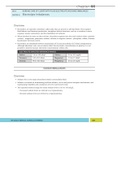chapter 44
UNIT 6 NURSING CARE OF CLIENTS WITH FLUID/ELECTROLYTE/ACID-BASE IMBALANCES
CHAPTER 44 Electrolyte Imbalances
Overview
● Electrolytes are minerals (sometimes called salts) that are present in all body fluids. They regulate
fluid balance and hormone production, strengthen skeletal structures, and act as catalysts in nerve
response, muscle contraction, and the metabolism of nutrients.
● When dissolved in water or other solvent, electrolytes separate into ions and conduct either a positive
(cations – magnesium, potassium, sodium, calcium) or negative (anions – phosphate, sulfate, chloride,
bicarbonate) electrical current.
● Electrolytes are distributed between intracellular (ICF) and extracellular (ECF) fluid compartments.
Although laboratory tests can accurately reflect the electrolyte concentrations in plasma, it is not
possible to directly measure electrolyte concentrations within cells.
ELECTROLYTE EXPECTED REFERENCE RANGES
Sodium 136 to 145 mEq/L Calcium 9.0 to 10.5 mg/dL
Potassium 3.5 to 5.0 mEq/L Magnesium 1.3 to 2.1 mEq/L
Chloride 98 to 106 mEq/L Phosphorus 3.0 to 4.5 mg/dL
SODIUM IMBALANCES
Overview
● Sodium (Na+) is the major electrolyte found in extracellular fluid.
● Sodium is essential for maintaining acid-base balance, active and passive transport mechanisms, and
maintaining irritability and conduction of nerve and muscle tissue.
● The expected reference range for serum sodium levels is 136 to 145 mEq/L.
◯ Decreased sodium levels are referred to as hyponatremia.
◯ Elevated sodium levels are referred to as hypernatremia.
RN ADULT MEDICAL SURGICAL NURSING 483
,CHAPTER 44 ELECTROLYTE IMBALANCES
Hyponatremia
● Hyponatremia is a net gain of water or loss of sodium-rich fluids that results in sodium levels less than
136 mEq/L.
◯ Hyponatremia delays and slows the depolarization of membranes.
◯ Water moves from the ECF into the ICF, causing cells to swell (cerebral edema).
◯ Compensatory mechanisms include the renal excretion of sodium-free water.
● Assessment
◯ Risk Factors
■ Causes of hyponatremia
☐ Deficient ECF volume
X Abnormal gastrointestinal (GI) losses – vomiting, nasogastric suctioning, diarrhea, tap
water enemas, gastrointestinal obstructions
X Kidney losses – diuretics, kidney disease, adrenal insufficiency
X Skin losses – excessive sweating, burns, wound drainage, ascites (as it relates to cirrhosis)
☐ Increased or normal ECF volume
X Excessive oral water intake
X Syndrome of inappropriate antidiuretic hormone (SIADH) – excess secretion of
antidiuretic hormone (ADH)
☐ Edematous states – heart failure, cirrhosis, nephrotic syndrome
☐ Excessive hypotonic IV fluids
☐ Inadequate sodium intake (nothing by mouth status [NPO])
■ Older adult clients are at a greater risk due to the increased incidence of chronic illnesses, use of
diuretic medications, and risk for insufficient sodium intake.
◯ Subjective Data and Objective Data
■ Clinical indicators depend on whether it is associated with a normal (euvolemic), decreased
(hypovolemic), or increased ECF (hypervolemic) volume.
■ Vital signs – hypothermia, tachycardia, rapid thready pulse, hypotension, orthostatic
hypotension (vital signs can vary based on state of ECF volume)
■ Neuromusculoskeletal – headache, confusion, lethargy, muscle weakness to the point of
possible respiratory compromise, fatigue, decreased deep-tendon reflexes, seizures
■ Gastrointestinal – increased motility, hyperactive bowel sounds, abdominal cramping, nausea
■ Laboratory Tests
☐ Serum sodium
X Decreased: less than 136 mEq/L
☐ Serum osmolarity
X Decreased: less than 270 mOsm/L
484 RN ADULT MEDICAL SURGICAL NURSING
, CHAPTER 44 ELECTROLYTE IMBALANCES
● Patient-Centered Care
◯ Nursing Care
■ Report abnormal laboratory findings to the provider.
■ Fluid overload: Restrict water intake as prescribed by the provider.
■ For clients who have heart failure and hyponatremia, provide loop diuretics and ACE inhibitors
as prescribed.
■ Acute hyponatremia
☐ Administer hypertonic oral and IV fluids as prescribed.
☐ Administer 3% sodium chloride slowly, and monitor sodium levels frequently.
☐ Encourage foods and fluids high in sodium (cheeses, milk, condiments).
■ Restoration of normal ECF volume: Administer isotonic IV therapy (0.9% sodium chloride,
lactated Ringer’s).
■ Monitor intake and output, and daily weight.
■ Monitor vital signs and level of consciousness; report abnormal findings to the provider.
■ Encourage the client to change positions slowly.
◯ Teamwork and Collaboration
■ Nephrology may be consulted for electrolyte and fluid replacement.
■ Respiratory services may be consulted for oxygen management.
■ Nutritional services may be consulted for food choices high in sodium and restricting
fluid intake.
◯ Care After Discharge
■ Client Education
☐ Encourage the client to weigh daily and to notify the provider of a 1- to 2-lb gain in 24 hr,
or 3-lb (1.4 kg) gain in a week.
☐ Instruct the client to consume a high-sodium diet, including reading food labels to check
sodium content, and keeping a daily record of sodium intake.
● Complications
◯ Acute Hyponatremia
■ Complications (coma, seizures, respiratory arrest) can result from acute hyponatremia if not
treated immediately.
■ Nursing Actions
☐ Maintain an open airway, and monitor client’s vital signs.
☐ Implement seizure precautions, and take appropriate action if seizures occur.
☐ Monitor the client’s level of consciousness.
RN ADULT MEDICAL SURGICAL NURSING 485




